Scarlet Evening Tails - Correct Etiquette - Please advise
-
mtcraymond
- Posts: 5
- Joined: Tue Mar 11, 2008 11:15 am
- Contact:
Gentleman I have a question that I am sure you will be able to answer, any help and advise that you can offer would be greatly recieved as I have spent lot of time trying to research this and can not find much help anywere.
I am having evening tails made for formal hunt functions, so basically white tie but the jacket being scarlet and I would appreciate any tips or knowledge that anyone has on this, here is what I have ordered so far.
Jacket,
Peak collar, ribbed silk facings, button hole on each lapel, button holes at the base of the tails, Tapered and slightly short sleaves, 4 buttons on sleave, breast pocket but no others.
Trousers,
No turn ups, side adjusters, brace buttons, high waist, single pleat, double stripe on leg,
Also Shoes, what shoes would I need for this, ballet pumps? what are they and are they the only choice.?
Any help advise or changes on the above would be greatly received.
Many Thanks
Mark
I am having evening tails made for formal hunt functions, so basically white tie but the jacket being scarlet and I would appreciate any tips or knowledge that anyone has on this, here is what I have ordered so far.
Jacket,
Peak collar, ribbed silk facings, button hole on each lapel, button holes at the base of the tails, Tapered and slightly short sleaves, 4 buttons on sleave, breast pocket but no others.
Trousers,
No turn ups, side adjusters, brace buttons, high waist, single pleat, double stripe on leg,
Also Shoes, what shoes would I need for this, ballet pumps? what are they and are they the only choice.?
Any help advise or changes on the above would be greatly received.
Many Thanks
Mark
Try reading these two threads:
http://thelondonlounge.net/gl/forum/vie ... 18547f90fb
http://www.thefedoralounge.com/showthread.php?t=7058
The coat you refer to is a type of "pink coat". If you look at the fox in the Thomas Pink logo - that's the colour coat he's wearing.

"Pink" was meant to make the hunter visible to other members of the hunting party. The only example of which I have a close up picture is of one dating from 1860-1880 and it has brass guilt buttons carrying the emblems of the pack.

As far as trousers go, it is my pet peeve that trousers with a dress coat must have flat fronts. Pleats are a modern innovation and work better with the looser fitting lounge coat than with body coats. However, there are some 1930s fashion plates depicting single and double pleats with dress coats, so it is up to you in the end. I happen to strongly feel that a dress coat should be be cut very close to your figure, with maximal waist suppression (that's what the waist seam is for dammit!) - bordering on being a bit tight fitting. The trousers should follow that aesthetic of the coat - hence slimmer cut flat fronted trousers. This is after all how the dress coat was originally worn as evening dress around the Georgian era:
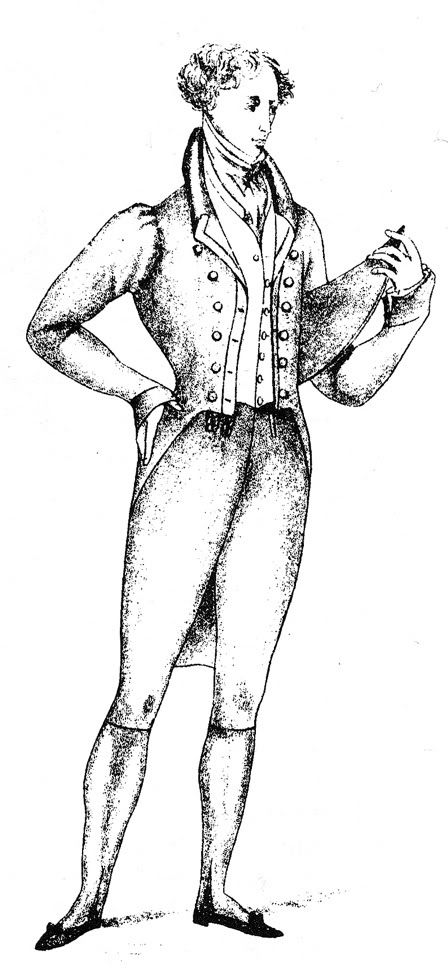
Even in the Edwardian era the silhouette of the dress coat was very sleek:

My tailor says, and quite rightly so IMHO, that a dress suit should lean towards being "tight fitting".
As for lapels, please note that in British English the correct term is "double breasted styled lapels". "Peak lapels" is an Americanism. Another option you may like to consider would be a shawl collar:
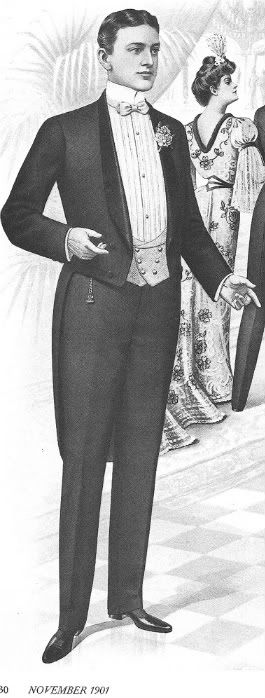
A pink coat would not usually take grosgrain facings as you describe. That is mostly only seen on a dress coat proper. You won't really find any red grosgrain anyway - at least I have never seen it in any books. That said I have found this historical example from Huntsman of Savile Row:
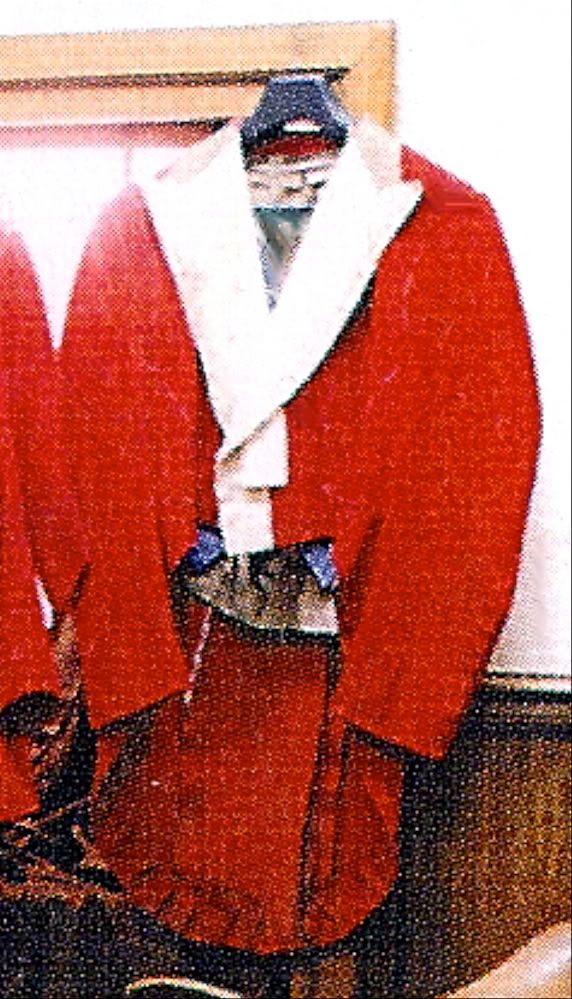
The construction of the front of this coat suggests that it was made before the 1920s. At that time the lapels were cut separately and stitched on later to the body of the coat. The part of the lapels cut separately on this above coat appear to be made of a white silk (there is a white grosgrain in the Holland & Sherry formal book).
Here is a pattern for a dress coat with the lapels cut separately:

Here is a close up of a body coat made with separately cut lapels:

If you lift up up the lapel you can see the seam running underneath it:

The difficulty is that tailors familiar with body coats are becoming fewer. And those who have made a body coat with lapels cut separately will be vanishingly few and most will never have done it in their lifetime. The only good news is that the example from Huntsman may be on display in their store. You may be able to go in and say "make me one of those". The bad news is that the extra difficulty and time that it involves to make such a coat is going to cost you dearly. Expect to pay 2.5-3x more than what it costs for a lounge coat.
Lastly, a word on footwear. The only footwear appropriate for evening full dress are court shoes, which are called that because they were historically worn as court dress, especially so in British English. They are also sometimes called opera pumps. However, they pre-date the birth of opera in the 17th century making them the oldest item in a man's wardrobe.
If you are going "all the way" with the "dress hunt coat" (as opposed to the more practical pink coat called the "field coat") I would certainly hope you will not skimp on this detail. I would strongly recommend going to Edward Green, who make a beautiful court shoe. I have pair on order myself with them and am expecting delivery imminently. Naturally, an even better option if you are going to make a trip to Savile Row is to drop in a bespoke shoemaker's store such as Cleverley or Gaziano & Girling etc to have a bespoke pair made for you.
Just one more pet peeve. A dress coat, or any coat of knee length should under no circumstance be referred to as a jacket . The term jacket is reserved for a coat which is short.
. The term jacket is reserved for a coat which is short.
I think that the expression "dinner jacket" refers to the fact that there was time when you wore a "dinner coat" it meant that you wore a dress coat, as that was the standard form of dinner dress. So "dinner jacket" is a way of emphatically saying "yes, I am wearing a coat for dinner, though a short one, rather than a proper dress coat". After all dinner jackets are still coats.
Next, I have never heard the term "ballet pumps" and as far as I know they were never intended for a ballet dancer. What is true is that throughout the Renaissance part of a gentleman's education involved the learning of proper refined court dances. As a consequence court shoes are also known as "dancing shoes".
Here is a painting of Elizabeth I dancing the volte with Robert Dudley:
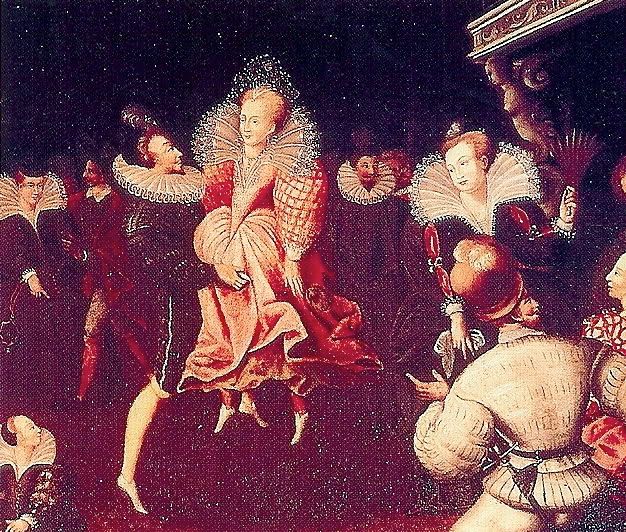
Naturally, Dudley is wearing court shoes.
http://thelondonlounge.net/gl/forum/vie ... 18547f90fb
http://www.thefedoralounge.com/showthread.php?t=7058
The coat you refer to is a type of "pink coat". If you look at the fox in the Thomas Pink logo - that's the colour coat he's wearing.

"Pink" was meant to make the hunter visible to other members of the hunting party. The only example of which I have a close up picture is of one dating from 1860-1880 and it has brass guilt buttons carrying the emblems of the pack.

As far as trousers go, it is my pet peeve that trousers with a dress coat must have flat fronts. Pleats are a modern innovation and work better with the looser fitting lounge coat than with body coats. However, there are some 1930s fashion plates depicting single and double pleats with dress coats, so it is up to you in the end. I happen to strongly feel that a dress coat should be be cut very close to your figure, with maximal waist suppression (that's what the waist seam is for dammit!) - bordering on being a bit tight fitting. The trousers should follow that aesthetic of the coat - hence slimmer cut flat fronted trousers. This is after all how the dress coat was originally worn as evening dress around the Georgian era:

Even in the Edwardian era the silhouette of the dress coat was very sleek:

My tailor says, and quite rightly so IMHO, that a dress suit should lean towards being "tight fitting".
As for lapels, please note that in British English the correct term is "double breasted styled lapels". "Peak lapels" is an Americanism. Another option you may like to consider would be a shawl collar:

A pink coat would not usually take grosgrain facings as you describe. That is mostly only seen on a dress coat proper. You won't really find any red grosgrain anyway - at least I have never seen it in any books. That said I have found this historical example from Huntsman of Savile Row:

The construction of the front of this coat suggests that it was made before the 1920s. At that time the lapels were cut separately and stitched on later to the body of the coat. The part of the lapels cut separately on this above coat appear to be made of a white silk (there is a white grosgrain in the Holland & Sherry formal book).
Here is a pattern for a dress coat with the lapels cut separately:

Here is a close up of a body coat made with separately cut lapels:

If you lift up up the lapel you can see the seam running underneath it:

The difficulty is that tailors familiar with body coats are becoming fewer. And those who have made a body coat with lapels cut separately will be vanishingly few and most will never have done it in their lifetime. The only good news is that the example from Huntsman may be on display in their store. You may be able to go in and say "make me one of those". The bad news is that the extra difficulty and time that it involves to make such a coat is going to cost you dearly. Expect to pay 2.5-3x more than what it costs for a lounge coat.
Lastly, a word on footwear. The only footwear appropriate for evening full dress are court shoes, which are called that because they were historically worn as court dress, especially so in British English. They are also sometimes called opera pumps. However, they pre-date the birth of opera in the 17th century making them the oldest item in a man's wardrobe.
If you are going "all the way" with the "dress hunt coat" (as opposed to the more practical pink coat called the "field coat") I would certainly hope you will not skimp on this detail. I would strongly recommend going to Edward Green, who make a beautiful court shoe. I have pair on order myself with them and am expecting delivery imminently. Naturally, an even better option if you are going to make a trip to Savile Row is to drop in a bespoke shoemaker's store such as Cleverley or Gaziano & Girling etc to have a bespoke pair made for you.
Just one more pet peeve. A dress coat, or any coat of knee length should under no circumstance be referred to as a jacket
I think that the expression "dinner jacket" refers to the fact that there was time when you wore a "dinner coat" it meant that you wore a dress coat, as that was the standard form of dinner dress. So "dinner jacket" is a way of emphatically saying "yes, I am wearing a coat for dinner, though a short one, rather than a proper dress coat". After all dinner jackets are still coats.
Next, I have never heard the term "ballet pumps" and as far as I know they were never intended for a ballet dancer. What is true is that throughout the Renaissance part of a gentleman's education involved the learning of proper refined court dances. As a consequence court shoes are also known as "dancing shoes".
Here is a painting of Elizabeth I dancing the volte with Robert Dudley:

Naturally, Dudley is wearing court shoes.
Last edited by Sator on Thu Mar 13, 2008 2:10 pm, edited 1 time in total.
-
mtcraymond
- Posts: 5
- Joined: Tue Mar 11, 2008 11:15 am
- Contact:
Dear Sator,
Thank you so much for your very promp reply, I see your point on the trousers being flat fronted and will change to this, I would still have them cut rather high I guess.?
Just to come back to you on the reference to Pink, as although I am no expert on the correct cut of cloth, on hunting I am far more knowledgeable. the coat to which you refer as a field coat is indeed refered to as "hunting Pink" but not in reference to the colour the colour is known as scarlet, the name pink is in reference to the maker of the garment a Mr Pink. These field coats are made from a very think wool, and are cut not to be flattering but for purpose, ie they are very stong and heavy, they protect the wearer from brambles, scrapes and the rest and from the cold, furthermore they keep you dry on a freezing miserable day, its amazing how dry as well, none of these modern manmade materials just wool and you can be out all day in driving rain and yet still stay dry... Incredible things.. The buttons again refer to which hunt the wearer belongs to, each hunt have there own distinctive buttons and members are invited to wear them when they have "come of age" and or shown suitable knowledge and compatance in the field, a true honour indeed. These coats are still worn although less so sinse the ban, what I am looking for is not this which I have but the formal evening coat for balls etc.
The pictures you have posted of the red coat with white facings is indeed a beautiful thing and I shall look them up, the white facings on the lapel are again a specific hunt item, some, not all, hunts wear coloured colours on there hunting jackets (pinks) these vary from white blues, I have seen mustards and many more and if you wear such a collar you would then have the facings of your dress coat to match.
Thank you again for your excellent pointers on the cut and construction, I couldnt agree with you more as to the tightness of the fit, and will certainly have mine cut in such a style, as to the shoes your quite right I have never heard them called ballet pumps either but opera pumps, and must have been having a mad minute when I wrote it, thank you for your suggestion on these I will certainly look them up.
Again thank you for the advise and shall be implementing your sugestions with my taylor.
Mark
Thank you so much for your very promp reply, I see your point on the trousers being flat fronted and will change to this, I would still have them cut rather high I guess.?
Just to come back to you on the reference to Pink, as although I am no expert on the correct cut of cloth, on hunting I am far more knowledgeable. the coat to which you refer as a field coat is indeed refered to as "hunting Pink" but not in reference to the colour the colour is known as scarlet, the name pink is in reference to the maker of the garment a Mr Pink. These field coats are made from a very think wool, and are cut not to be flattering but for purpose, ie they are very stong and heavy, they protect the wearer from brambles, scrapes and the rest and from the cold, furthermore they keep you dry on a freezing miserable day, its amazing how dry as well, none of these modern manmade materials just wool and you can be out all day in driving rain and yet still stay dry... Incredible things.. The buttons again refer to which hunt the wearer belongs to, each hunt have there own distinctive buttons and members are invited to wear them when they have "come of age" and or shown suitable knowledge and compatance in the field, a true honour indeed. These coats are still worn although less so sinse the ban, what I am looking for is not this which I have but the formal evening coat for balls etc.
The pictures you have posted of the red coat with white facings is indeed a beautiful thing and I shall look them up, the white facings on the lapel are again a specific hunt item, some, not all, hunts wear coloured colours on there hunting jackets (pinks) these vary from white blues, I have seen mustards and many more and if you wear such a collar you would then have the facings of your dress coat to match.
Thank you again for your excellent pointers on the cut and construction, I couldnt agree with you more as to the tightness of the fit, and will certainly have mine cut in such a style, as to the shoes your quite right I have never heard them called ballet pumps either but opera pumps, and must have been having a mad minute when I wrote it, thank you for your suggestion on these I will certainly look them up.
Again thank you for the advise and shall be implementing your sugestions with my taylor.
Mark
In my understanding Mr Thomas Pink is a factional character altogether, along with the fox wearing the pink coat. However, pink (small 'p') is the term used to describe the deep red colour used for hunting coats. In older parlance 'pink' is another term for red - hence the thing about "pinko commie so and so's"  in the cold war era.
in the cold war era.
The coat with the guilt buttons I have shown is in fact a dress-hunt coat rather than a field coat. The reason is that especially in the early 19th C, all dress coats used to have guilt buttons on them. This practice appeared to have continued longer into the late 19th C with dress-hunt coats. Some unsuccessful attempts were made as late as the Edwardian era to revive guilt buttons on standard dress coats.mtcraymond wrote: The buttons again refer to which hunt the wearer belongs to, each hunt have there own distinctive buttons and members are invited to wear them when they have "come of age" and or shown suitable knowledge and compatance in the field, a true honour indeed.
Here Beau Brummell c1805 sports a dress coat with guilt buttons:
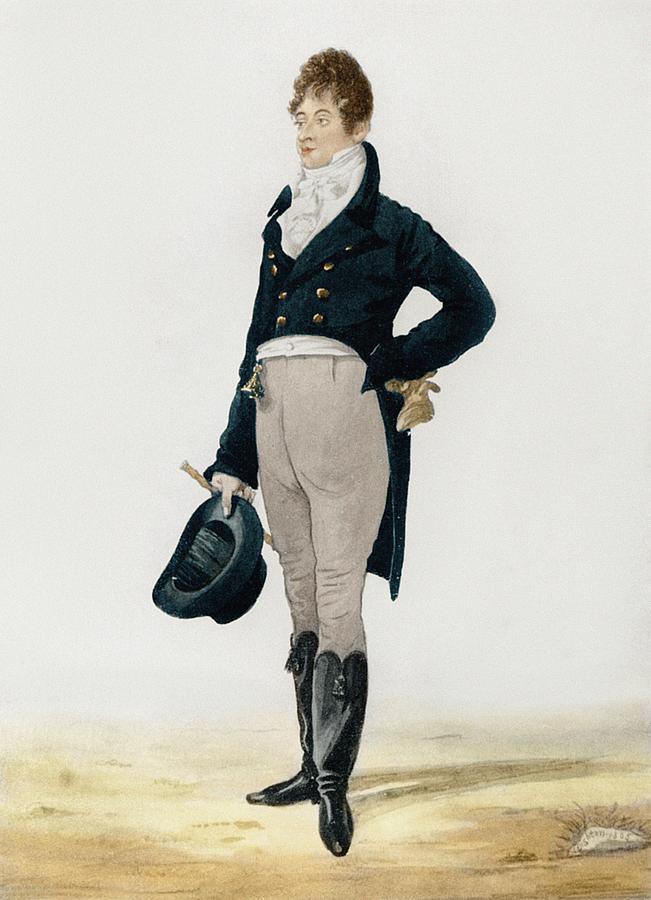
-
mtcraymond
- Posts: 5
- Joined: Tue Mar 11, 2008 11:15 am
- Contact:
Thank you Sator,
In terms of the origin of the name pink I have always believed it to be the maker as do it would seem many others, but am happy to be corrected
http://www.messdress-britishmilitaria.c ... pinks.html
http://www.horseandhound.co.uk/competit ... 69945.html
http://www.icons.org.uk/theicons/collec ... ng-fashion mind you this doesnt look so deffinate..
The buttons are actually an interesting point as I have already ordered what are standard guilt hunt buttons for evening wear, with my hunt initials on them, but these are always flat, well they are nowadays anyway, so maybe I should actually put normal guilt hunt buttons on, (as normally on hunting pinks) these are like the ones featured in your pictures with a dome shape to them as these would seem to be more tradtional.. It would certainly be a statement as I know of no one with them on their dress coats...
One thing that does really stand out is how far standards and style have slipped over the years, it seems such a shame that such beautiful clothes are just not available anymore..
Thanks again.
In terms of the origin of the name pink I have always believed it to be the maker as do it would seem many others, but am happy to be corrected
http://www.messdress-britishmilitaria.c ... pinks.html
http://www.horseandhound.co.uk/competit ... 69945.html
http://www.icons.org.uk/theicons/collec ... ng-fashion mind you this doesnt look so deffinate..
The buttons are actually an interesting point as I have already ordered what are standard guilt hunt buttons for evening wear, with my hunt initials on them, but these are always flat, well they are nowadays anyway, so maybe I should actually put normal guilt hunt buttons on, (as normally on hunting pinks) these are like the ones featured in your pictures with a dome shape to them as these would seem to be more tradtional.. It would certainly be a statement as I know of no one with them on their dress coats...
One thing that does really stand out is how far standards and style have slipped over the years, it seems such a shame that such beautiful clothes are just not available anymore..
Thanks again.
-
storeynicholas
Hunting scarlet is worn in most of the British Isles, except Ireland, where they wear green. The phrase 'in the pink' denoting happiness is said by some to derive from the satisfaction which customers of the tailor Thomas Pink had with his hunt coats. Hunting scarlet may well derive from the principal colour of royal livery since hunting rights like other estates and interests in land in the UK derive from the Crown. The cloth in hunt coats is a felt-like cloth called Melton. I think that pleats in formal trousers are now pretty standard. You obviously know about the facings and hunt colours. Although the evening coat should pretty well follow your body lines, just remember that ballls are for eating, drinking and dancing, so not too tight. So far as I know, the coat facings are never black. You could just about opt for evening breeches with an evening hunt coat for a ball. If you do, be sure that you will be ribbed and so be prepared to answer back by being able to sweep the prettiest girl there away into a slow tango.
NJS
NJS
- culverwood
- Posts: 402
- Joined: Fri Jun 23, 2006 3:56 pm
- Location: London
- Contact:
Hunt balls have joined the decline in dress standards with rest of society and should the OP turn up in a scarlet tailcoat he will no doubt be one of the best dressed. Whatever his trousers he will stand apart from the rabble and if he has the balls to wear it no doubt he will be able to stand any ribbing.
-
mtcraymond
- Posts: 5
- Joined: Tue Mar 11, 2008 11:15 am
- Contact:
Thank you I would like to say that in the two packs I hunt with quite a few of the subscribers do still wear red tails for balls, so standards are being mantained thank god, although normally just with the older members. Breeches would look fantastic but I'm afraid to say that even I dont quite have the balls for that..... Lovelly idea though and thanks
-
storeynicholas
I was being flippant about the evening breeches. Probably one of the the last people to wear them publicly was WSC on his retirement as PM. It is interesting that wearing Brummell's invention of pantaloons (which gradually took over from breeches) once actually got the Iron Duke barred at the doors of Almack's Club in King Street St James's where, for some time breeches, remained de rigueur. Now nearly 200 years later, hardly anyone would dare to wear breeches, except (ceremonially) - Judges and senior lawyers in some jurisdictions and those obliged to wear certain livery. Still worth learning to perform a slow tango though and, as a benchmark, Valentino's performance in Four Horsemen of the Apocalypse ( a clip available on Youtube) - old and crackling though the footage is - takes some beating - even now.
best,
NJS
best,
NJS
-
mtcraymond
- Posts: 5
- Joined: Tue Mar 11, 2008 11:15 am
- Contact:
Flipant perhaps but I was serious I really do wish I had the balls.... Alas I think my wife would leave me... The Tango however is a different story I really must lean, no point looking the part if you cant be the part...... Thank you for that reminder I must get onto it....
-
HappyStroller
- Posts: 442
- Joined: Tue Oct 03, 2006 9:29 pm
- Contact:
I believe red refers a commie while pinko refers to a fellow traveler.
Sator wrote:In my understanding Mr Thomas Pink is a factional character altogether, along with the fox wearing the pink coat. However, pink (small 'p') is the term used to describe the deep red colour used for hunting coats. In older parlance 'pink' is another term for red - hence the thing about "pinko commie so and so's"in the cold war era.
-
HappyStroller
- Posts: 442
- Joined: Tue Oct 03, 2006 9:29 pm
- Contact:
I thought trousers with braces are worn with dress coats, such as frock coats, morning cutaways, strollers, dinner jackets and evening tailcoats. And such trousers usually have waists a few inches larger than those of the equivalent pants which do not use braces. This is supposed to result in more comfort for the wearer with only the braces holding up the trousers. Also, such trousers are usually tailored with a pair or two pairs of forward pleats.
Can I conclude you do not use braces for your dress coat trousers?
Also, those modern elastic pantaloons, which many ladies used for their gym workouts seems about as tight as plain front pants can get.
Can I conclude you do not use braces for your dress coat trousers?
Also, those modern elastic pantaloons, which many ladies used for their gym workouts seems about as tight as plain front pants can get.
Sator wrote:...<snipped>...
As far as trousers go, it is my pet peeve that trousers with a dress coat must have flat fronts. Pleats are a modern innovation and work better with the looser fitting lounge coat than with body coats. However, there are some 1930s fashion plates depicting single and double pleats with dress coats, so it is up to you in the end. I happen to strongly feel that a dress coat should be be cut very close to your figure, with maximal waist suppression (that's what the waist seam is for dammit!) - bordering on being a bit tight fitting. The trousers should follow that aesthetic of the coat - hence slimmer cut flat fronted trousers. This is after all how the dress coat was originally worn as evening dress around the Georgian era:
Even in the Edwardian era the silhouette of the dress coat was very sleek:
My tailor says, and quite rightly so IMHO, that a dress suit should lean towards being "tight fitting".
...<snipped>...

-
- Information
-
Who is online
Users browsing this forum: No registered users and 78 guests
